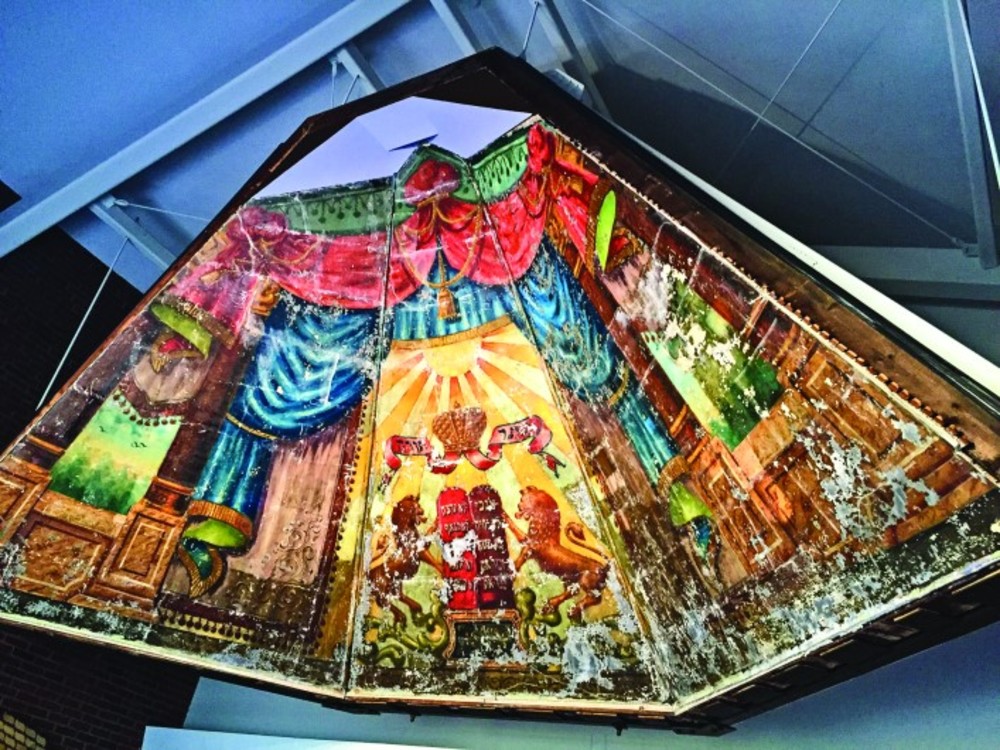‘The Lost Shul Mural’ finds a new home
 “The Lost Shul Mural”
“The Lost Shul Mural”
In the world of Jewish folk art, there are few realities quite as sad as the lost era of beautiful paintings, murals and architecture produced by the Jews of Eastern Europe. These intensely detailed works reflected hiddur mitzvah, making the sacred beautiful. Such artifacts were all but obliterated in the Shoah.
Recently, a mural dubbed “The Lost Shul Mural” resurfaced in Burlington, Vermont. The enormous three-panel piece (22 feet long by 11 feet high) was initially found in 1986 during renovations to the original Chai Adam Synagogue in the former “Little Jerusalem” section of the city. Many believe this synagogue to be the first in Burlington, and possibly the entire state of Vermont.
The mural, painted on-site in 1910 for $200 by commissioned Lithuanian artist Ben Zion Black, was reluctantly abandoned behind a new wall during the renovation after the Jewish community of Burlington was unable to raise enough money to pay for its removal and preservation.
After exhausting all possibilities for support, the leaders of the Jewish community did what they could to document the piece through photographs. Aaron Goldberg, a member of local synagogue Ohavi Zedek, spearheaded this process, and dreamed of one day reclaiming the exquisite mural for the Jewish community.
That effort took more than 25 years. In 2012, Ohavi Zedek began a three-year removal, installation and preservation process, headed by Rhode Island native Robert Schwartz, president of Great Northern Construction of Burlington.
“I wasn’t afraid of this project; I think a lot of other contractors would have been,” Schwartz said in an interview.
Hung like a picture on four 3/4-inch threaded rods, the mural was raised in May by four small winches to hang on a custom, $75,000 steel frame in Ohavi Zedek. And that wasn’t even the hard part: The front façade of the synagogue had to be completely removed to install the piece, which hangs suspended above the main lobby. There was just 1 7/8 inches to spare above as the piece was gently moved into place.
“At any moment we could have ended up with a big pile of beach sand,” Schwartz says with a laugh.
Featured in the Vermont Building and Architecture’s Historic Preservation issue this past November, Schwartz was named Remodeler of the Year by the Home Builders and Remodelers Association of Northern Vermont for his outstanding work removing and installing a piece characterized by project conservator Connie Silver as “like 20,000 tiny cornflakes.”
Before the piece was installed, it needed extensive prep work, including creating a temporary housing arrangement while it awaited the application of a stabilizing compound. The compound, used to stabilize restoration projects in Egypt, prevented the mural from disintegrating further.
“We built a small building with a heating system to hold the mural while we waited the 30 days for the compound to arrive and be applied,” Schwartz said. The enclosure alone cost $200,000.
Once installation was complete, the 6,500-pound artifact and steel frame hung suspended from another steel frame, built to appear as though it is part of the Ohavi Zedek rafters.
The colorful mural depicts the lions of Judah holding the Ten Commandments upon a throne. The lions are flanked by heavy drapes, musical instruments and prayers written in Hebrew.
After a century of fading, these drapes appear dark green, but pictures from 1986 show that they were actually painted a vivid electric blue. The sun pours light upon this scene, illuminating the entire backdrop, while the Crown of Torah hovers above the throne.
From a preservation perspective, it is quite lucky that these photos were taken in 1986. The years between 1986 and 2010 were deeply unkind to the mural. Coal dust, cigarette smoke and grime had settled over the varnish, which had all but completely deteriorated. The photos will help preservationists restore original colors and hues.
According to international Jewish folk art historian Dr. Samuel D. Gruber, the piece represents “one of only a small number of extent ‘East European’ synagogue murals … it is a gift that adds color, vitality and the immediacy of piety.”
Gruber is director of Gruber Heritage Global, a private consulting firm, which includes the Jewish Heritage Research Center in Syracuse, New York. His lectures on this type of art and Eastern European religious architecture have kick-started an aggressive fundraising campaign to help begin the next phase: the actual restoration of the mural.
EDITOR’S NOTE: To support restoration of The Lost Shul Mural, send contributions to “Ohavi Zedek’s Mural Fund” and mail to Ohavi Zedek Synagogue, 188 North Prospect St., Burlington, Vt. 05401. To donate online, go to lostshulmural.org.
LEAH C. BOURAMIA is an educator, wife and the mother of two rambunctious boys. She lives in Warwick.







